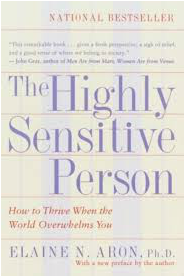
Many people with Borderline Personality Disorder (BPD) may also relate to the description above. Individuals with BPD are often very sensitive to environmental factors and other forms of stimulation (or lack thereof). For both HSPs and people diagnosed with BPD, there is often an optimal range of stimulation that is very narrow. In fact, there are many parallels between BPD and being an HSP, and Dr. Aron’s book provides information that can be helpful to both groups.











 RSS Feed
RSS Feed